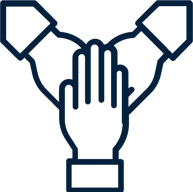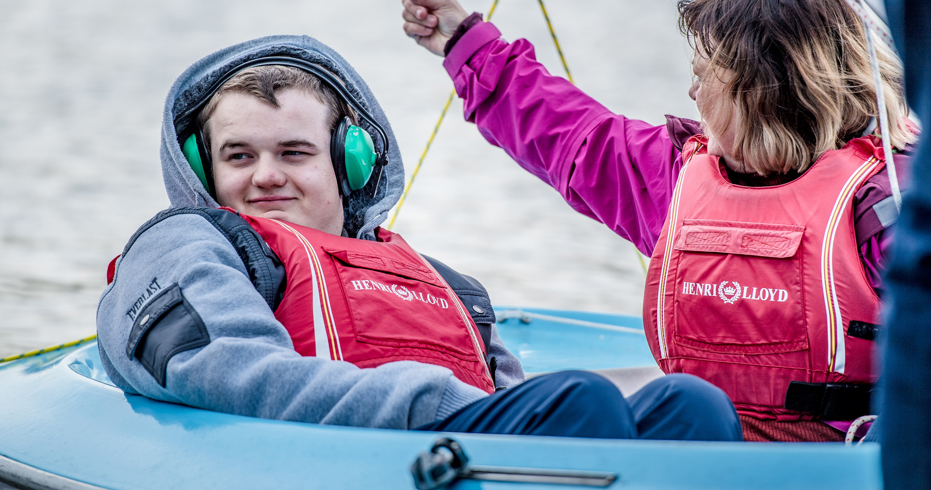NETWORK
Sailability safety practice guidance
Guidance around safety practice where disabled people and those with long term health conditions are taking part
Introduction
Guidance around safety practice where disabled people and those with long term health conditions are taking part
This guidance is for staff and volunteers responsible for delivering training or providing support around safety on the water during Sailability related activities.
The Sailability programme has delivery principles
Fun
I feel welcome and have fun

Safe
I feel safe and can raise my concerns

Open
I am able to take part

The guidance supports these principles from a safety perspective and considers a number of issues:
- Personal flotation
- Self righting boats
- Adaptations to boats, including servos and switches
- Recovering boats
- Recovering people
- Seating and posture
The guidance supplements existing RYA safety related information, courses and RYA Training Guidance. It reflects the issues that may need to be considered given a range of complex and diverse personal needs that some sailors have.
Key messages
- You need a systematic approach to safety
- Familiarise yourselves with the knowledge, competencies and techniques covered in the RYA Safety boat course
- Plan for the worst, and test the procedures you have in place
- Boats and equipment should be well-maintained and regularly checked
- Familiarise yourself with the boats and equipment you are using
- Record and reflect on accidents, incidents and near misses
- Discuss sailors’ individual needs with them
- If you have sailors who may have restricted ability to help themselves if they end up in the water, carefully consider the level of safety cover you need in the immediate vicinity, mast head buoyancy, reducing sail area, and when the conditions may limit activity
An approach to safety
Getting on the water safely takes a systematic approach
Safety systems will necessarily have functional, concise documents – the chances are if you don’t write it down it won’t happen, but success equally depends on people, their attitudes and behaviours – and the safety culture you establish.
A safety system is likely to have the following elements.
Structure and risk management
- Scope and responsibilities are defined
- Hazards and risks are assessed
- Controls and procedures are detailed
Culture and promotion
- Competent people are given responsibility and authority
- People know what to do and how to do it
- People accept the risk and choose to take part
Assurance
- The right equipment is used properly
- Proactive and reactive learning takes place and changes are identified as a result
RYA resources
The RYA Safety boat course, the Safety Boat Handbook (G16) and accompanying resources outline a range of knowledge, competencies and techniques for ensuring people are safe and the towing and recovery of different types of craft. The content is relevant, fit for purpose and applicable to the craft commonly used by disabled people across the Sailability programme. It is regularly reviewed in light of learning from experience and a range of incidents. It is important the techniques and skills are practiced in context – with the boats frequently in use during Sailability activity.
Procedures, preparation and regular checks
It is important to have procedures in place for a variety of situations and have people who know the procedures, have tested them and are ready for action. We never set out thinking things will go wrong but experience shows they can, and although rate there can be serious consequences. Understanding cause and effect is important in assessing risk, but often in the most serious incidents it is not one factor but a number of factors that contribute often in unexpected ways. Plan for the worst and test the procedures you put in place.
The preparation of boats and equipment is key to being able to apply the right techniques and procedures. Preparation should include (but is not limited to) the identification and regular checking of:
- Towing points and towing lines (on sailing and safety boats),
- Recovery / righting lines,
- Any device(s) for securing lifting keels and ballasted centreboards,
- Bungs,
- Knives for cutting through ropes and rigging,
- Pumps, bailers and buckets to remove large amounts of water
- Equipment and techniques to get people out of the water (and out of boats once back on pontoon) who may not be in a position to help themselves.
An essential equipment checklist should be in place for all vessels in use, and is a valuable tool to ensure preparation and regular checks take place. Recognised Training Centres have checklists for vessels they must comply with:
Those involved in decisions to go afloat or not and in providing safety cover should have a good knowledge of the vessels being sailed, their characteristics and limits, how they are rigged, and how they can be easily de-powered. The weight carrying capacity of the craft should be considered.
Communication
Good communication is at the heart of making good decisions and managing activities smoothly. It ensures:
- Information is shared with those who need to know,
- Activity on the land and on the water is co-ordinated,
- The right people do the right things in an emergency,
- Sailors are reassured, listened to and made to feel safe and welcome.
Reporting incidents and near misses
We learn the most as a community. Most of the time that comes about by celebrating our successes; from sharing the procedures we put in place, the assessments and judgements we make and collating learning from the testing and drills we carry out. Sometimes we get to learn from near misses and sadly but thankfully rarely we learn from those times when things do go wrong.
Sharing of information is the invaluable for imparting knowledge, influencing behaviour and controlling risk. Reporting incidents and near misses is a vital component. Being open and honest about what happens when things go wrong, helps us all to improve the culture of safety and good practice.
The RYA has detailed a number of triggers for reporting and recording accidents and incidents and there is an online form to use to make reporting straight forward.
Report an accident or incident
The RYA has detailed a number of triggers for reporting and recording accidents, along with an online form to make reporting straightforward.
People
Providers of activity have a clear duty of care to keep those involved in the activity safe. People of all ages, with a wide range of impairments go sailing.
The equipment to keep disabled people safe, and the techniques you use to recover them from a boat or from the water may vary as a result. It is important to consider:
- The person
- The situation
- The staff / volunteers supporting the activity
Leading to:
- A decision or series of decisions
The Person
The person going sailing knows themselves, what they can and can’t do, how they function and react. The club or centre and its staff and volunteers know about sailing. A conversation[1] between both parties will provide all the information needed to make good decisions about safety.
The person, the sailor, is at the heart of the conversation and every effort should be made to include them however difficult communication may prove to be. If needs be, and if the person agrees, you may choose to have a conversation with others who know the person well.
The situation
Any assessment has to take into account where you are boating, the type of activity you are engaged in and the conditions on the day. Consider:
- The sailing area and the conditions on the day
- The nature of the activity and the boats / equipment being used
- The organisations’ scope of responsibility, liability and any constraints e.g. insurance
Staff / Volunteers
While one person may make the decision whether the activity goes ahead and what resources are needed to ensure any activity is safe, there will be a number of staff and / or volunteers involved in helping with the delivery of the activity. Consider:
-
The competence and experience of the staff and volunteers supporting the activity and their familiarity with the equipment being used,
- The questions they have and the training they need,
- Who needs to know about the conversation with the sailor and decisions made – it’s a balance between discussing needs in a private environment and sharing information on a ‘need to know basis’.
Decision
The process leads to a decision that both sailor and competent person are comfortable with on whether to sail or not, and the equipment and resources needed to deliver a safe activity.
Personal flotation
It is important to get the choice of personal flotation device right each time a person goes afloat, particularly for people who may not be able to actively participate in their own self-righting if they were to end up in the water.
The RYA’s website has information about buoyancy aids and lifejackets, but a useful start point is:
Buoyancy aids
- suitable where you might reasonably expect to end up in the water, for example if there is a risk of capsize or inversion.
- work well for conscious people and for those with enough mobility to actively participate in their self-righting
- an aid to buoyancy where it is assumed help is close at hand.
Lifejackets
- suitable where you do not expect to enter the water, for example where it is not anticipated the vessel will capsize or invert.
- they can turn an unconscious person or someone who cannot actively participate in their self-righting into a safe position and require no subsequent action by the user to maintain this position.
- can increase the risk of entrapment where there is a risk of capsize or inversion.
All flotation devices should be well maintained, serviced and be ready for use. Remember the devices only work if they are worn.
Lifejackets and buoyancy aids have different levels of buoyancy and for self-inflating lifejackets, different mechanisms to trigger auto-inflation – all of which will influence the choice you make.
The person
Factors related to the person are likely to have more of an impact on the performance of flotation devices than the characteristics of the device itself. Specifically, if using a lifejacket which is designed to self-right, self-righting can never be guaranteed due to a wide range of variables.
The variables include but are not limited to:
- Swimming ability
- The ability to actively participate in self-righting once in the water,
- The way people are likely to fall into the water (for example people may slip out of the boat head first and end up face down) and whether this will affect the performance of personal flotation device, particularly trigger mechanisms,
- The buoyancy of the person – as a general rule people with more buoyant legs may require a larger volume flotation device. Buoyancy in legs might be affected by muscle wastage (muscle has negative buoyancy) and bone density,
- The size and shape of the person – for example a small and thin person with a wide lifejacket may find self-righting capacity is impaired,
- The clothing the person is wearing can have a significant impact on buoyancy. Dry suits and anything that enhances buoyancy around the legs can have a negative impact on an individual’s ability to right themselves, or a lifejacket’s self-righting capacity,
- Whether a person is likely to accidently or deliberately activate an auto inflate mechanism.
The environment
Factors relating to the environment should also influence choice, including:
- The vessel - its stability and righting ability
- The conditions
- The activity
- The sailing area
General
Whatever device is chosen by the sailor or a competent person allocating equipment the following are important points to remember:
- Always take into account the characteristics of the specific device, have it tested against their body type; and ensure all concerned are aware of the device’s limitations.
- The experience of falling into the water can be quite challenging. So the value of familiarisation of entering the water and experiencing how the chosen flotation device performs cannot be overstated.
- If using a lifejacket which is designed to self-right, self-righting can never be guaranteed due to a wide range of variables.
- Fixed life-jackets rather than auto / manual inflate may be less effective at self-righting – the inflatable life-jackets may provide some momentum as one chamber inflates ahead of the other.
Implications for practice and procedures
- Identify who is competent to allocate and fit personal flotation devices to sailors and ensure they are aware of the issues discussed in this document,
- Implement a process to identify which participants may not be able to actively participate in their self-righting if they were to be in the water,
- In an environment where it is possible a sailor could end up in the water, and a careful risk assessment leads to a decision to use a life-jacket for people with limited mobility who may not be able to actively participate in self-righting once in the water, it is important to plan for:
- Informing the safety fleet of who is afloat with a life-jacket.
- ensuring there is safety cover in the immediate vicinity.
- reducing sail area and using mast head flotation (which reduces but may not eliminate the risk of inversion
- the area of operation.
- the thresholds for stopping activity.
Strapping and harnesses
Strapping and other equipment are used for several reasons including to maintain posture and improve control of sails and steering. Straps and harnesses can be used by a person day to day (for example, in a wheelchair) or as a specific part of sailing equipment.
Boating is an activity that takes place on water, and there are hazards (both on the shore or launching areas, and on vessels) that increase the chances a person may end up in the water with the risk of drowning as a result.
Implications for practice and procedures
- A sailor using a wheelchair should not be strapped to their chair while on a pontoon, slipway or other location where there is a risk of the chair falling into the water.
- Any strapping or equipment designed for fixing sailors to boats to maintain posture or improve control of sails / steering, or for any other reason should be very carefully risk assessed and procedures put in place because of the increased risk of entrapment.
- If it is decided that a sailor should be secured to a vessel for any reason, the method of securing should be a quick release type and those responsible for safety should be familiar with the mechanism. Buckles that require positive release using two fingers are not appropriate. For example, many side release buckles require pressure on both sides to release.
Self righting boats
Self-righting means different things for different vessels. An all-weather lifeboat can recover from a full 180-degree inversion. On a vessel with a fixed keel, self-righting may well mean that the vessel can recover from beyond the point where the mast is horizontal in the water.
Some vessels with a centre plate are considered self-righting with no crew on board, with the centre plate down, and the mast at no more than 90 degrees.
Experience shows self-righting boats can and do get ‘knocked down’ or capsize, increasing the risk of inversion and entrapment. There are known examples where through a variety of factors they have subsequently inverted, including with the keel or weighted centre board retracted. There are known examples where a sailor has slipped out of a knocked down boat, increasing the risk of entrapment and reducing the ability to right the boat. If you are faced with such a situation, the important thing is knowing what to do and how to do it.
Mitigations, such as mast head floats, may increase the time a boat is on its side rather than inverted.
Manufacturers will use owner manuals and guides to share information about a vessel’s limitations (e.g. rigging, safety features, conditions, number of people, load).
Some sailors may have restricted mobility or ability to help themselves if they ended up in the water or partially in the water. Equipment is available to maintain posture or improve control of steering / sails that has the effect of securing the sailor to the vessel. Both of these factors can increase the risk of entrapment.
Boats with a ballasted lifting keel are heavy and while the standard techniques to right them work, they may require more power.
The self-righting characteristics of any boat are compromised if a lifting keel or weighted centreboard are not in the down position, as is the ability to right from an inverted position.
Actively trimming sails, rather than cleating them off enables them to be released quickly if needed.
Implications for practice and procedures
- Users of any vessel should familiarise themselves with its stability and righting characteristics.
- Use vessels within the limits and safety features described by the manufacturers.
- Any mechanism for securing the plate or keel in the down position should be checked to ensure it is operating as intended and all sailors and volunteers should be briefed on the importance of its use.
- Brief volunteers, instructors and participants about the value of actively trimming sails rather than cleating them off.
- If a sailor is limited in their ability to help themselves if they ended up in the water or where they are secured to the vessel in any way, it is worth considering additional mitigations:
- mast head buoyancy
- reducing sail area
- the level of safety cover to ensure supervision in the immediate vicinity.
- when the conditions may limit operation (see manufacturers recommendations).
- Procedures and drills for recovering a 'self-righting' boat should include scenarios where a) the boat has inverted with the keel in the lowered position and b) where the keel or centreboard has retracted from its ‘lowered’ position,
- When choosing engine size and vessel type for safety boats, consider the types of vessels you may be recovering,
- The preference is to right a knocked down or inverted boat in reverse, with the engine away from anyone who may be in the water. However, if low engine power may cause concern and potentially restrict the ability to recover the craft, you could consider using a longer tow rope and recover by driving forwards.
Adaptations to boats
Any modifications that deviate from the original design specification may alter the stability characteristics of that vessel and access to the full range of controls (steering and sails).
Servos and switch operated controls can be used to increase access to steering and sail trimming. They are complex systems that do have limitations and are operating in a dynamic environment.
Implications for practice and procedures
- Check any modifications with the original manufacturer.
- Any adaptations should take into account the need for the crew to have access to the full range of tiller movement and sail controls.
- Servos, and switch operated controls should have an override in place that is easy to access and quick to use that releases the steering / and or sails quickly.
- Those responsible for safety should be familiar with how the servo / switch operates.
- Supervision is needed by someone who can solve problems as they arise on the water.
- As with other adaptations, modifications as a result of servos / switches should be checked with the original manufacturer, unless using manufacturer supplied equipment.
- Servo and switch operated systems should be designed to operate safely in a dynamic, wet environment.
- If servos and switch operated controls are to be used, a careful risk assessment should be in place, with consideration given to:
- the stability characteristics of the vessel used
- the level of safety cover needed
- reducing sail area and mast head flotation
- the area of operation
- the thresholds for stopping activity (see manufacturers recommendations)
Recovering boats
When towing vessels participants usually remain in the boat
The seating arrangements in some vessels used for disabled people, and participants’ own limited mobility, may make it harder for the crew to stay out of the way of a tow rope, particularly if multiple vessels are being towed.
Safety fleets are used to having plans in place to recover the entire fleet or deal with multiple issues on the water (which may or may not involve towing the fleet). Many disabled sailors staying in their boat may be the safest and quickest way to recover them.
Implications for practice and procedures
- The Herringbone tow might be preferable to in-line tows as the tow ropes are clear from sailors in the boat.
- If they are empty, a stern first tow of Hansa's is particularly effective.
- The safety lead will need consider how many people you can transfer easily to safety boats and how many people will need to stay in their boat.
Recovering people
Slings or wet nets such as the Hypo hoist or Jacobs Cradle are an effective means of recovering people from the water if they are unable to help themselves for any reason but they can be a difficult experience for both the safety team and participants, so familiarisation is important.
Other techniques in the Safety Book (G16) remain fit for purpose, including deflating a sponson of a RIB.
A risk assessment may identify individuals who will be difficult to recover from the water due to a combination of factors, including an inability to help themselves and their size. It is important to have a plan for all sailors where they can either be recovered to their own vessel or a safety boat.
There are situations where a sailor may need to get ashore quickly. Standard procedures usually involve abandoning the sailing vessel and returning to shore with the sailor in a safety boat. For people with limited mobility, who may need equipment to get them in and out of the boat, it may be preferable to leave them in their boat and tow them ashore. It is important to communicate with the shore team so that the right people and equipment are in place on your arrival.
Implications for practice and procedures
- Consider additional equipment such as hypo hoists or Jacobs cradles that may be needed to recover people
- Practice use of hypo hoists, Jacobs cradle etc if you have them
- Develop individual plans for sailors to be recovered to their own vessel or a safety boat, who due to a combination of factors have been assessed as difficult to recover if they were to end up in the water.
- Establish good communication between the safety and shore teams so that the right people and equipment are available when needed
Seating and posture
Seating and posture are important for both personal safety and the ability to take an active part in sailing.
The aim is to build a secure posture from the base up thereby ensuring comfort and enabling movement and generation of force to control steering / sails and self.
Implications for practice and procedures
- Use a conversation with the sailor to gather information and make decisions about seating and posture. Take advice if needed. Take into account:
- The person’s experience and competence
- Skin care (pressure, friction, moisture)
- Stability of airways, joints and bones
- Any pain and how it is managed
- Check that you have got posture right for the person
- If in doubt, stop the activity, review and change posture early

Sailability
Boating at your pace, adapted for you.
